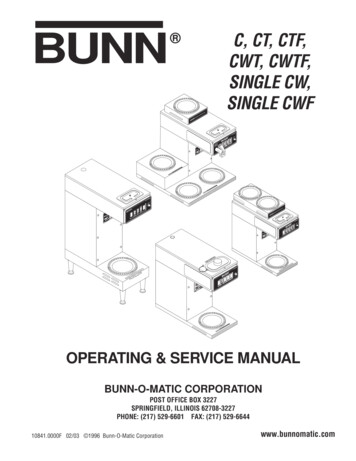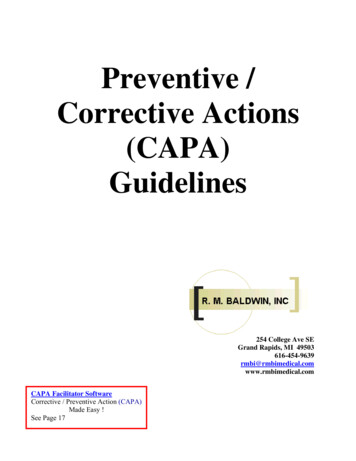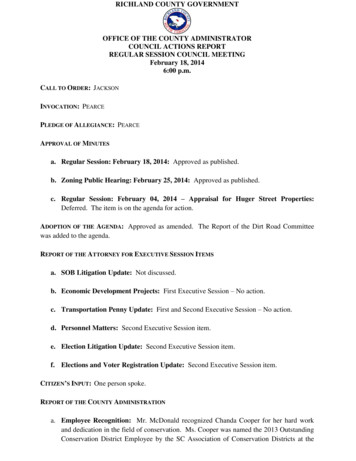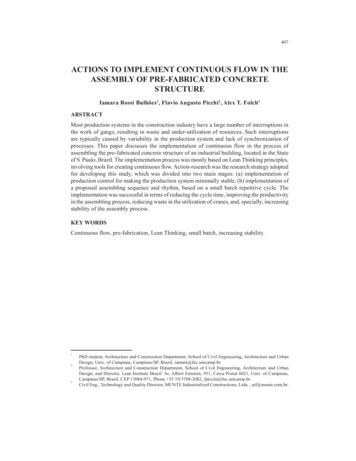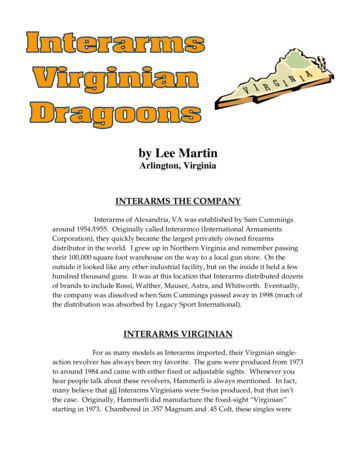
Transcription
by Lee MartinArlington, VirginiaINTERARMS THE COMPANYInterarms of Alexandria, VA was established by Sam Cummingsaround 1954/1955. Originally called Interarmco (International ArmamentsCorporation), they quickly became the largest privately owned firearmsdistributor in the world. I grew up in Northern Virginia and remember passingtheir 100,000 square foot warehouse on the way to a local gun store. On theoutside it looked like any other industrial facility, but on the inside it held a fewhundred thousand guns. It was at this location that Interarms distributed dozensof brands to include Rossi, Walther, Mauser, Astra, and Whitworth. Eventually,the company was dissolved when Sam Cummings passed away in 1998 (much ofthe distribution was absorbed by Legacy Sport International).INTERARMS VIRGINIANFor as many models as Interarms imported, their Virginian singleaction revolver has always been my favorite. The guns were produced from 1973to around 1984 and came with either fixed or adjustable sights. Whenever youhear people talk about these revolvers, Hammerli is always mentioned. In fact,many believe that all Interarms Virginians were Swiss produced, but that isn’tthe case. Originally, Hammerli did manufacture the fixed-sight “Virginian”starting in 1973. Chambered in .357 Magnum and .45 Colt, these singles were
very similar in size to a Peacekeeper and its Italian clones. The frames were colorcased hardened with blued barrels and cylinders, while the backstraps werechrome plated. The predominant barrel length was 5.5”, though 4 5/8” and 7.5”were offered as well.The first review of the Interarms Virginian was in the May 1973issue of American Rifleman, and it was a favorable one at that. At a time whennumerous companies produced Peacekeeper style revolvers, the HammerliVirginian was one of the smoothest. Unfortunately, many may have overlookedthe gun if they went on appearance alone. This isn’t to say that they were ugly,just that they looked like any other Colt knock-off. The grips were one-pieceplain walnut like the old 1873, and I believe that the two were interchangeable.The case hardening was nice, but very close in color and pattern to the Italianreplicas. All were half-cock guns, used the standard blade front/notch rear sightsystem, and had two-piece back straps. One unique feature of the Virginianhowever was the “Swiss Safety” mechanism. Whereas many single-actions usedtransfer bar or anvil link systems, Hammerli employed a long base pin thatcontained two latch positions. The first allows the hammer to contact the firingpin, thus discharging the gun. If however it was set to the second latch, thehammer is blocked from contacting the firing pin. It’s certainly not the mostadvanced safety system, but it does work. All Hammerli models were shippedin a red felt-lined box, used the serial prefix “C-XXXX, and were imported byInterarms up until 1976. Although the Virginian was a very well built singleaction, only a couple of thousand were ever produced. They can still be found inthe used market, but the ones I’ve seen go for 500 and up depending on theircondition.MIDLAND, VIRGINIA & THE DRAGOONIn 1976, production was assumed by Interarms Industries ofMidland, VA. The decision to break ties with Hammerli was largely based ondollar depreciation as experienced in the mid-1970s. In other words, as U.S.currency was devalued, it became unprofitable to import the Virginian. SamCumming’s solution involved a 25,000 square foot plant that was built on theedge of a 350 acre farm. Ten of the 350 acres was for the production site, whilethe remaining 340 was farmed. At its peak, the staff totaled around 70, withmost of the workers being long-time residents of Fauquier County. I’ve beenthrough Midland and can say that it’s the last place you’d expect guns to bebuilt .nice little town, but if you blink in passing, you’ve missed it.Nonetheless, Midland was convenient for three reasons: 1) It’s right next to amajor railway and rural airport, 2) It’s only an hours drive from the Interarms
warehouse in Alexandria, and 3) The 10 acre site provided room for expansion.At this time, the adjustable sight “Virginian Dragoon” was introduced in .44Magnum, with the only finish being blued & color-case. While.357 Mags and .45Colts were catalogued, they weren’t actually made until the late 70s or early 80s.It’s also rumored that the Midland plant produced a few fixed-sight Dragoonsfrom 1976 to late 1977. Though they were listed on the Interarms price sheet, I’venever actually seen the fixed sight variation.Unlike the old Hammerli guns, Interarms had the HitchnerCorporation cast a heavier frame to accommodate the .44 Magnum round. Oncepoured using either 4140 steel or 416 stainless, they were then shipped toMidland for final spec machining. In terms of strength and overall dimensions,these were very close to that of a Blackhawk, except the top-strap was morecurved. A second noticeable difference was a slot that was cast about a quarterof an inch below the top of the frame. This characteristic became a trademark ofsorts for the Interarms Dragoon and it does make the gun easily identifiable.Another trademark is the engraving done on the bottom of the gripframe. MostDragoons were inscribed with either “Don’t Tread On Me” with snake logo orthe untranslated Virginia state motto “Sic Semper Tyrannis “. The former wasused on the earlier guns, circa 1976 to 1978. At least three other inscriptions existthough to include: 1) “We the People 1776 – 1976”, 2) “Yorktown 1781 – 1981”,and 3) “Liberty Forever” (see variants). Cylinder dots were also drilled to the leftand right of one bore to indicate the empty chamber. It was a smallenhancement, but a useful one at that. Other changes include one-piecebackstraps, brazed front sights, recessed cylinders, coil mainsprings, internalfiring pins, and split grip panels (note: unlike Ruger, Interarms used a “locked”firing pin bushing). Unfortunately, the walnut grips themselves are notinterchangeable with any other single-action model. As a result, when buyingreplacement panels, you have to either go the custom route or find ones that arespecific to the Virginian Dragoon. Two sources include Eagle Grips @www.eaglegrips.com and Gun Grip @ www.gungrip.com.; I’ve used both, andhighly recommend Eagle over the latter. Despite the fact that the grips werehand fit to the gun, many did crack over time.I’ve heard a lot of people say that the quality of the Dragoon was lessthan that of the old Hammerli Virginians. I’d have to disagree with thisstatement however, at least for the guns built after 1979. While the HammerliVirginians did have smoother actions, they were no better in terms of functionaltolerances. Secondly, such a comparison makes no sense in that the Virginianwas a Colt clone, whereas the Dragoon was both dimensionally andmechanically closer to a Blackhawk (internal vs. external firing pins, one-piecevs. two piece backstraps, fixed vs. variable sights, etc). Regardless, I believe thatmuch of this opinion centers around the Dragoons made between the years of
1976 – 1979. Indeed, some of the early guns did have timing issues and all werenotorious for having rough bores. Cylinder fit was good, but their finish andaccuracy were mediocre. Another common problem was over-sized throats,with the .45 Colts being as large as 0.458”. In hindsight though, one might expectthis from a new production line, and as more guns were built, quality slowlyimproved. Profitability did not however, and three years into the model run, theDragoon was still very much in the red. That’s when Sam Cummings hired RodSward.QUALITY & VARIANTSRod Sward possessed two things that were of great benefit to theMidland plant: 1) He had a strong background in production & qualityoversight; his previous job had been in Florida for a company that producedordinance fuses, and 2) He was a gun person. As a result, Sam Cummings madeRod the Vice President of Interarms around 1980. Along with Bud Woerheide,who was the production manager, quality and profitability improved within amatter of months. But Rod’s contribution went beyond balance sheets, in that heapplied a few technical innovations. For instance, Rod greatly enhanced theaccuracy of the silhouette model by free-boring ½” of the barrel. Secondly, eachchamber of a finished cylinder was proofed, unlike the standard practice of firingjust one round. Lastly, a much greater emphasis was placed on the hand fittingand tuning of the Virginian Dragoon. In the end, these added quality controlsproduced Dragoons that were built to very close tolerances. In fact, theVirginians made after 1980 locked-up tighter than most factory built singleactions I’ve encountered (short of those made by Freedom Arms). That includesRugers, El Dorados, Sevilles, BFRs, Abilenes, Ubertis, Herters,.etc. Larger boltand cylinder stops definitely contributed to this, as did extremely close fitbetween the two (bolt and cylinder stop widths ran within 0.001” of eachother).Production of the Interarms Virginian increased significantly underRod Sward. Within a year of his arrival, the plant was manufacturing 300 – 400guns a week, and by early 1983, some 60,000 had come out of Midland. What’snever been well documented though is the “which & when” of caliber selection.The majority of the Dragoons I see are in .44 Magnum, with the .45 Colt being thenext most common. .357 Magnums do exist, but they’re pretty rare, and the .41Magnum is a mystery. Early on, Interarms catalogued the .357 and .41Magnums, but it wasn’t until the 1980s that they became a reality. Eventually,they did churn out some .357s, but the .41s are a point of great debate. Some saythat short of prototypes, they were never offered to the public. Others allege thata thousand or so .41s were produced from around 1981 to 1984. I have recently
been in touch with a couple of individuals who have blued .41s, so they do exist,but are quite rare. In fact, in all my years of collecting single-actions, I’ve neverseen a .41 Magnum Dragoon. If anyone has pictures or information on thischambering, please drop me a line at sc429@yahoo.com. Some other interestingvariants include: Bicentenial Edition – built in 1976. The bottom of the backstrapwas engraved with, “We the People, 1776-1976”. Yorktown Edition – built in 1981. These were either blued orstainless and had “Yorktown 1781 – 1981” engraved on the bottomof the grip frame. Blued Frame .44s – adjustable sight guns with blued, not colorcase, frames. Silhouette Dragoons – introduced in 1982 in either blue orstainless. The majority were 10.5” barrels, but a 7.5” & 8 3/8” couldbe ordered (partridge front sights were standard). The barrels werefree-bored ½” and they came with two sets of grips. .Pachmyrsand plain walnut. Deputy Model – a fixed sight gun with blued frame and goldhammer/trigger. Calibers were .357 Magnum, .45 Colt, and .44Magnum. Introduced around 1983 and most had 5” barrels. Some.44s and .357s were done in stainless. Serial number prefix was “D” .22 Virginian – introduced in early 1983, these were built forInterarms by Uberti. These were either blued with case hardenedframes or were stainless. They could also be ordered with anauxiliary .22 MagnumPRODUCTION ENDSInterarms stopped manufacturing the Virginian towards the end of 1984.Dragoons were available through all of 1985 and some of 1986, but these werereally back-stocked guns from the 1984 run. While the model was profitable inthe early 1980s, eventually there wasn’t enough demand to warrant full-scaleproduction. List price was also an issue in that a new Blackhawk could be hadfor around 200 in the mid-1980s the Virginian Dragoon on the otherhandstarted at 280. Beyond price points however, Interarms never quite found theirniche in the single-action market. Ruger and Uberti covered the “moderately”priced field, while companies such as Freedom Arms, El Dorado Arms, Colt, andUnited Sporting Arms had the high-end share. Stuck in the middle, the
Virginian Dragoon also faced competition from Mossberg’s Abilene, which wasproduced from 1980 – 1983. In the end, it too was discontinued.I’ve always liked the Virginian Dragoons, even though I’ve spentmost of my time working with Rugers, Sevilles, and El Dorados. Ironically, myfirst single-action was an Interarms .44 Magnum that I got when I was nine. Oneday, my dad came home from the gun store with two new Dragoons and calledmy sister and I into the kitchen. He laid both on the table, and said, “Take yourpick when you’re old enough to shoot stuff this big, they’re yours”. Mysister took the blued version, while I grabbed the stainless. Over the years, I hadlargely forgotten about this gun as my dad and I got more and more into Rugerconversions. To this day, they both remain new-in-the-box.If anyone has additional information or photos of these guns,please feel free to write me at sc429@yahoo.com .I’m always interested inlearning more about these revolvers.YEAR19811985MODELVirginian DragoonFINISHBluedBluedBluedBluedCALIBER.357 Mag.41 Mag.44 Mag.45 ColtBARREL5", 6", 7.5"6", 7.5"6", 7.5", 8 3/8"5", 6", 7.5"MSRP 250 250 250 250Virginian DragoonStainlessStainlessStainlessStainless.357 Mag.41 Mag.44 Mag.45 Colt5", 6", 7.5"6", 7.5"6", 7.5", 8 3/8"5", 6", 7.5" 280 280 280 280Virginian BuntlineBluedStainlessAllAll12"12" 340 370Virginian DragoonBluedStainless.44 Mag.44 Mag6", 7.5", 8 3/8"6", 7.5", 8 3/8" 280 295Virginian SilhouetteStainless.44 Mag7.5", 8 3/8", 10.5" 425Virginian EngravedBluedStainless.44 Mag.44 Mag6", 7"6", 7.5" 625 625Virginian DeputyBlued.357 Mag5" 285.22 VirginianBlued.22 LR6" 265Select Interarms Virginian Dragoon price-sheets from 1981 & 1985.Interarms still catalogued the guns for another year, even though productionended in 1984PICTURES – see below
Hammerli Virginian in .357 MagnumVirginian Dragoons - .44 Magnum, Sic Semper version (top), .357 MagnumDeputy Model, Liberty Forever Version (bottom)
Virg
of brands to include Rossi, Walther, Mauser, Astra, and Whitworth. Eventually, the company was dissolved when Sam Cummings passed away in 1998 (much of the distribution was absorbed by Legacy Sport International). INTERARMS VIRGINIAN For as many models as Interarms imported, their Virginian single-action revolver has always been my favorite. The guns were produced from 1973 to around
